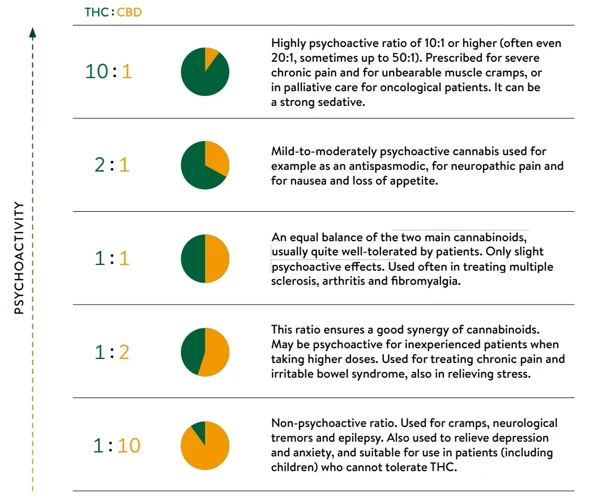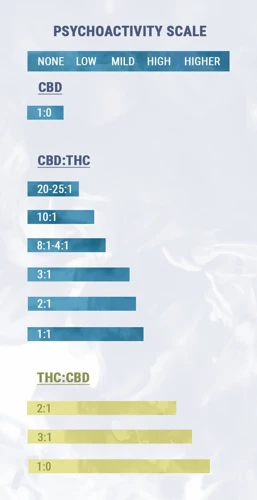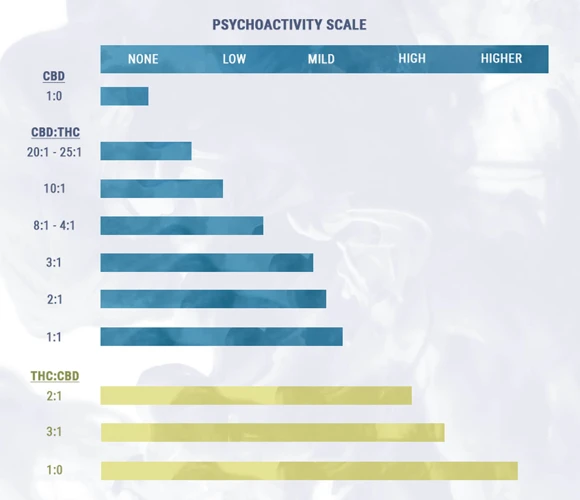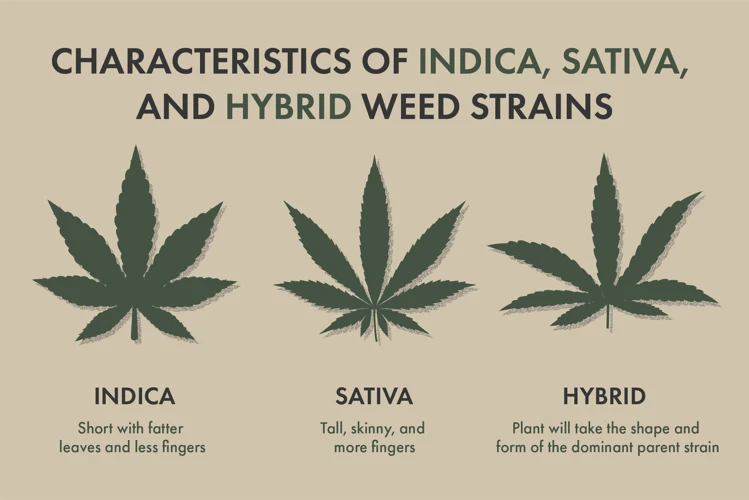
Choosing the Right Cannabis Strain Based on THC to CBD Ratios
As the world of cannabis continues to evolve, the variety of strains available can be overwhelming. With different THC to CBD ratios, sativa vs indica vs hybrid types, and varying cultivation techniques, it can be difficult for even experienced cannabis growers to choose the right strain for their needs. That’s why we’ve put together this guide, to help you navigate the complex world of cannabis strains and choose the one that best suits your medical needs or desired effects. Let’s dive in and explore the world of THC to CBD ratios and beyond.
THC vs CBD: What’s the Difference?
Contents
When it comes to understanding cannabis strains and how to choose the right one, it all comes down to THC and CBD. These two compounds are the most well-known and researched, but their effects on the body and mind can be quite different. THC, or tetrahydrocannabinol, is known for its psychoactive effects that can lead to feelings of euphoria and altered sensory experiences. On the other hand, CBD, or cannabidiol, has gained popularity for its potential therapeutic benefits without the psychoactive effects. But what are the actual differences between these two compounds, and how do they affect the strain you choose?
THC
THC stands for tetrahydrocannabinol, which is the main psychoactive compound found in the cannabis plant. THC is the primary chemical responsible for the “high” experienced by recreational cannabis users. It works by binding to CB1 receptors in the brain and nervous system.
Here are some key points to keep in mind about THC:
- THC is the most well-known compound in cannabis and is responsible for the plant’s psychoactive effects.
- When consumed, THC can create feelings of euphoria, relaxation, and altered sensory perception.
- THC has been found to have several potential medical benefits, including pain relief, muscle relaxation, and appetite stimulation.
- However, THC has also been linked to negative side effects, such as anxiety, paranoia, and impaired coordination, especially at higher doses.
- The THC content in cannabis varies from strain to strain, and can range from very low (less than 1%) to very high (over 30%).
THC is just one of many compounds found in cannabis, and its effects can be influenced by other cannabinoids present in the plant. This is why it’s important to consider the THC to CBD ratio when choosing a strain, as well as other factors like strain type, growing conditions, and personal medical needs and preferences.
CBD
CBD, short for cannabidiol, is another important compound found in cannabis. It is non-psychoactive, meaning it does not cause the “high” associated with THC. CBD has been shown to have numerous health benefits, including reducing anxiety, relieving pain and inflammation, and helping with certain seizure disorders.
Benefits of CBD:
- May reduce anxiety
- Has anti-inflammatory properties
- May help with certain seizure disorders
- May relieve pain
- May help with insomnia
- May reduce the risk of diabetes and obesity
- May have neuroprotective properties
Many medical cannabis patients choose strains with higher CBD content to help with their specific conditions or symptoms. It is important to note that the effects of CBD can vary depending on the individual and the specific strain or product.
Methods of Consumption:
- Smoking
- Vaping
- Tinctures and oils
- Edibles
- Topicals
CBD can be consumed in a variety of ways, including smoking or vaping, tinctures and oils, edibles, and topicals. Each method has its own advantages and disadvantages based on factors such as bioavailability, duration of effects, and personal preference.
CBD is a valuable compound with numerous potential health benefits. When choosing a strain based on THC to CBD ratios, it is important to consider both your medical needs and the desired effects, as well as the specific strains available.
THC:CBD Ratios
When it comes to choosing a strain, the ratio of THC (tetrahydrocannabinol) to CBD (cannabidiol) is an important factor to consider. THC and CBD are two of the most well-known compounds found in cannabis, each with its own unique effects.
Here are some common THC:CBD ratios you may come across:
- High-THC strains: These strains typically have a THC:CBD ratio of 20:1 or higher. They are known for their potent psychoactive effects, making them popular for recreational use.
- THC-dominant strains: These strains have a THC:CBD ratio of around 10:1. They are still potent, but may offer more balanced effects than high-THC strains.
- Balanced strains: These strains have an even THC:CBD ratio, usually around 1:1. They are popular among medical cannabis patients seeking a combination of pain relief and mental clarity.
- CBD-dominant strains: These strains have a THC:CBD ratio of 1:20 or lower. They offer therapeutic benefits without the psychoactive effects of THC, making them a popular choice for medical patients who want to be clear-headed throughout the day.
It is important to note that the effects of a strain do not depend solely on its THC:CBD ratio. Other compounds in cannabis, such as terpenes, also play a role in how a strain affects the body and mind.
Finding the Right Balance
When it comes to choosing the right strain for your needs, it’s all about finding the perfect balance between THC and CBD. THC offers a high, while CBD offers a range of medicinal benefits – so do you prioritize getting a buzz or soothing medical symptoms? With so many options available, it can be perplexing to determine what will work best for you. But fear not, by considering your personal needs and preferences, you can start down the path towards finding the ideal marijuana strain.
Consider Your Medical Needs
When choosing a strain based on THC to CBD ratios, it’s important to consider your medical needs. Every individual responds differently to cannabinoids, which means that what works for one person may not work for another. Here are some factors to consider:
- Symptoms: What symptoms are you trying to manage? THC is generally more effective for pain, nausea, and insomnia, while CBD is more effective for anxiety, seizures, and inflammation.
- Tolerance: What is your tolerance level? If you’re new to cannabis, you may want to start with a strain that has a lower THC content to avoid any negative side effects.
- Medical history: Do you have any pre-existing medical conditions? Some medical conditions can be exacerbated by THC, so it’s important to consult with your doctor if you have any concerns.
- Medications: What medications are you currently taking? THC can interact with certain medications, so it’s important to check for any potential drug interactions.
By considering these factors, you can determine the appropriate THC to CBD ratio that will provide the most effective relief for your specific medical needs. Keep in mind that finding the right strain may require some trial and error, so it’s important to be patient and pay attention to how your body responds to different ratios.
Think About the Desired Effects
When it comes to choosing a strain based on THC to CBD ratios, one important factor to consider is the desired effects. Different strains can produce vastly different psychoactive and medicinal effects. Below is a table outlining some common effects of high-THC, high-CBD, and balanced strains:
| Desired Effect | High-THC Strains | High-CBD Strains | Balanced Strains |
|---|---|---|---|
| Euphoria/Intense High | Yes | No | Yes, but less intense |
| Pain Relief/Relaxation | Yes | Yes | Yes, but less intense |
| Anxiety/Paranoia | Yes | No | No |
| Energy/Improved Focus | Yes | No | Yes, but less intense |
| Sleep Aid | No | Yes | Yes, but less intense |
It’s important to note that individual experiences can vary greatly, even among strains with similar THC to CBD ratios. Factors such as genetics, tolerance, and method of consumption can all impact the effects felt by the user. It’s always a good idea to start with small doses and monitor your reactions before consuming larger amounts. If you have any concerns about using cannabis for medicinal purposes, it’s best to consult with a qualified healthcare provider.
Understanding Strain Types
As a cannabis grower, it is essential to understand the different strain types available to you. Each strain type offers a unique set of benefits and characteristics. Sativa strains are known for their uplifting, energizing effects, while Indica strains tend to be more relaxing and sedative. Hybrid strains are a combination of the two and offer a balanced experience. With so many options available, it can be perplexing to know which strain type is right for you. Let’s dive deeper into the differences between these strain types and how they can affect your cannabis experience.
Sativa vs Indica vs Hybrid
When it comes to choosing a cannabis strain, understanding the differences between sativa, indica, and hybrid strains is crucial. Each strain offers distinct characteristics and effects, making it important for growers and users to know what they’re getting into before consuming. Let’s take a closer look at the differences between sativa, indica, and hybrid strains in the table below:
| Strain Type | Main Characteristics | Common Effects |
|---|---|---|
| Sativa | Tall and thin plants with narrow leaves; grow best in warm environments and take longer to mature. | Energetic and uplifting; can enhance creativity and productivity; may cause anxiety or paranoia in some individuals. |
| Indica | Short and bushy plants with wide leaves; grow best in cooler environments and have a faster maturation time. | Relaxing and sedative; can provide pain relief and promote sleep; may cause couch-lock or grogginess. |
| Hybrid | Combines characteristics of both sativa and indica plants; can lean towards one type more than the other. | Effects vary depending on the specific hybrid strain. |
As you can see, sativa and indica strains have distinct physical characteristics and effects. Sativa strains are often preferred for daytime use or activities that require a lot of energy and focus, while indica strains are commonly used for relaxation or as a sleep aid. Hybrid strains can offer a mix of both, depending on the specific strain’s genetic makeup.
So, when choosing a strain based on THC to CBD ratios, it’s important to also consider the strain type and its effects. Users should think about their desired experience and choose a strain that aligns with those goals.
Popular Strains and Their Ratios
When it comes to finding the right cannabis strain based on THC to CBD ratios, it can be helpful to familiarize yourself with some of the most popular strains and their ratios. Here are some of the strains you may come across:
| Strain | THC:CBD Ratio | Type | Effects |
| Harlequin | 5:2 | Sativa-Dominant Hybrid | Relaxation without sedation; pain relief; anxiety relief |
| Cannatonic | 1:1 | Hybrid | Relaxation without sedation; pain relief; anxiety relief |
| ACDC | 20:1 | Hybrid | Relaxation without sedation; pain relief; anxiety relief; anti-inflammatory |
| Charlotte’s Web | less than 0.3% THC | Hybrid | Anti-inflammatory; anti-anxiety; anti-seizure |
| Girl Scout Cookies | 25:1 | Hybrid | Relaxation; euphoria; pain relief; appetite stimulation |
| OG Kush | 3:1 | Hybrid | Relaxation; euphoria; pain relief |
| Sour Diesel | 1:2 | Sativa | Energy; focus; creativity; mood elevation; pain relief |
| Grand Daddy Purple | 2:1 | Indica-Dominant Hybrid | Relaxation; sedation; mood elevation; pain relief |
Harlequin is a sativa-dominant hybrid that is known for its high CBD content, making it a popular choice for individuals seeking the therapeutic benefits of CBD without a lot of psychoactive effects. Cannatonic is another popular choice for those seeking a balanced THC to CBD ratio. ACDC is a hybrid strain that is high in CBD and low in THC, making it a good choice for individuals seeking pain relief and anti-inflammatory benefits. Charlotte’s Web, on the other hand, is a strain that is very low in THC and high in CBD, making it an excellent choice for individuals seeking a non-psychoactive option for anxiety, inflammation, and seizures.
Girl Scout Cookies, OG Kush, Sour Diesel, and Grand Daddy Purple are all popular strains that have different THC to CBD ratios, but are generally higher in THC. These strains are known for their psychoactive effects and are popular for recreational purposes. It is important to note that higher THC content does not necessarily mean better or more effective. As previously mentioned, it all depends on the individual’s medical needs and desired effects.
It is important to research and experiment with different strains and ratios to find the one that works best for you. Understanding the different strains and their ratios can be a helpful starting point in your search.
Growing Your Own
For those who want to take cannabis cultivation to the next level, growing their own plants can be an exciting and rewarding experience. With the ability to control every aspect of the growing process, from seed selection to harvest, you can ensure that your plants are producing the desired THC to CBD ratios. But where do you start? What seeds should you choose? And how can you cultivate plants with high levels of THC or CBD? In this section, we’ll explore the answers to these questions and help you get started on your own cannabis growing journey.
Choosing the Right Seeds
When it comes to growing your own cannabis, choosing the right seeds is crucial. Here are some factors to consider:
- Strain: Decide which strain you want to grow based on your personal preferences and medical needs. Look for strains with the THC:CBD ratio that suits you best.
- Breeder: Choose a reputable breeder that offers high-quality seeds with good genetics. Do your research and read reviews before making a purchase.
- Type: Consider whether you want regular, feminized, or auto-flowering seeds. Regular seeds can produce male or female plants, while feminized seeds are guaranteed to produce only female plants. Auto-flowering seeds are great for beginners as they automatically switch from the vegetative to flowering stage.
- Growing conditions: Take into account the growing conditions you have available. Some strains are better suited to indoor or outdoor growing, and some require specific temperatures or humidity levels.
Once you have chosen your seeds, it’s time to start the cultivation process. Remember to follow the instructions carefully and provide your plants with the right nutrients, light, and water to ensure a successful harvest.
Cultivation Techniques for High-THC or High-CBD Plants
When it comes to growing cannabis, cultivation techniques can greatly affect the levels of THC and CBD in the final product. For those seeking to grow potent, high-THC or high-CBD plants, it’s important to pay attention to the methods used. Below are some tips for cultivating high-THC and high-CBD plants:
| Cultivation Technique | High-THC Plants | High-CBD Plants |
|---|---|---|
| Strain Selection | Choose a strain with a high THC content, such as OG Kush or Girl Scout Cookies | Choose a strain with a high CBD content, such as ACDC or Charlotte’s Web |
| Lighting | Provide intense light for at least 12 hours per day during the flowering stage. Use high-intensity discharge (HID) lighting for best results. | Provide a balance of blue and red spectrum light for optimal CBD production. LED lighting is a popular choice for growing high-CBD plants. |
| Nutrients | Use nutrients high in nitrogen and phosphorus during the vegetative stage, and then switch to nutrients high in potassium and phosphorus during the flowering stage. | Use organic nutrients and supplements to promote CBD production. Avoid using synthetic fertilizers, as they can hinder CBD production. |
| Temperature and Humidity | Maintain a temperature range of 68-77°F (20-25°C) during the day and 50-68°F (10-20°C) at night. Keep humidity levels between 40-50% during the vegetative stage and 50-60% during the flowering stage. | Maintain a slightly cooler temperature range of 65-75°F (18-24°C) during the day and 60-70°F (15-21°C) at night. Keep humidity levels between 45-55% during all stages of growth. |
| Harvesting | Allow flowers to fully mature before harvesting, as THC levels can continue to increase even after the plant stops growing. Harvest when the trichomes turn amber or milky white. | Harvest when CBD levels are at their highest, which is typically at the end of the flowering stage. Look for buds that are dense and covered in resinous trichomes. |
By following these best practices for cultivation, growers can increase the chances of producing high-THC or high-CBD cannabis plants. However, it’s important to note that genetics play a major role in determining THC and CBD levels, and factors such as soil quality, water pH, and air circulation can also affect plant growth. With experience and experimentation, growers can fine-tune their techniques and achieve the desired cannabinoid ratios in their cannabis plants.
Buying from Dispensaries
For those who do not want to grow their own cannabis, or do not have the necessary resources to do so, buying from a dispensary is a popular option. With so many strains and products available, it can be overwhelming to make a choice. However, with a bit of knowledge and guidance, you can find the right strain with the optimal THC:CBD ratio to suit your needs. In this section, we will explore the important factors to consider when buying from a dispensary, including reading labels, understanding ratios, and asking the right questions.
Reading Labels and Understanding Ratios
When buying cannabis from a dispensary, it’s important to understand the labeling and ratios of THC and CBD. Here are a few key things to keep in mind:
- Look for the ratios: The THC to CBD ratio should be clearly labeled on the packaging. For example, a ratio of 1:1 would indicate equal amounts of THC and CBD in the strain. A ratio of 3:1 would indicate three times as much THC as CBD.
- Know what you’re looking for: Depending on your medical or recreational needs, you may want a strain with a specific ratio. For pain management, a high CBD strain may be more effective. For relaxation and euphoria, a high THC strain may be preferred.
- Understand the percentages: THC and CBD percentages should also be labeled on the packaging. For example, a strain may have a ratio of 3:1, but the THC percentage may only be 10%. This means that even though there is more THC than CBD, the overall potency may be lower than other strains.
- Consider the terpenes: Terpenes are the oils responsible for the aroma and flavor of the plant. They also contribute to the overall effect of the strain. Look for strains with high levels of specific terpenes if you want a certain flavor or effect.
- Research the strain: Before purchasing a strain, do some research on the effects and potential side effects. Every strain is unique and may affect individuals differently.
Understanding the labels and ratios is crucial to finding the right strain for your needs. Take the time to read and research before making a purchase. Don’t be afraid to ask your budtender for assistance and recommendations.
Questions to Ask Your Budtender
When buying cannabis from a dispensary, it’s important to speak with a knowledgeable budtender who can help guide you in selecting a strain based on your needs. Here are some key questions to ask your budtender:
- What is the THC:CBD ratio? This should be the first question you ask. Understanding the ratio will help you choose a strain that aligns with your desired effects and medical needs.
- What strain type is it? Sativa, indica, or hybrid? Knowing the type of strain can give you a better idea of the plant’s overall effects and characteristics.
- What are the terpene profiles? Terpenes are the aromatic compounds that give each strain its unique smell and taste. They can also have therapeutic properties and alter the effects of THC and CBD. Ask about the terpene profile to get a better understanding of how a strain may affect you.
- What are the common effects? Your budtender should be able to give you an idea of what effects you can expect from a particular strain. Ask about common side effects as well, such as dry mouth or red eyes.
- What is the recommended dosage? This will vary depending on the individual and the specific strain. It’s important to start with a low dose and gradually increase until you find your optimal level.
- Are there any potential drug interactions? If you’re taking other medications or supplements, it’s important to make sure there won’t be any negative interactions with cannabis. Your budtender may be able to provide some guidance or recommend consulting with a healthcare provider.
By asking these questions, you’ll have a better understanding of the strain you’re considering and can make a more informed decision. Your budtender is there to help, so don’t hesitate to ask for their expertise.
Conclusion
In conclusion, choosing the right strain based on THC to CBD ratios is crucial for achieving the desired effects while considering your medical needs. Both THC and CBD offer unique benefits, and finding the right balance for your needs is essential. Whether you choose to grow your own or buy from a dispensary, understanding strain types and ratio labels is important. When buying from a dispensary, don’t be afraid to ask questions and seek guidance from a knowledgeable budtender. Cultivating high-THC or high-CBD plants requires different techniques, but choosing the right seeds and following proper cultivation practices can increase your chances of success. Ultimately, the key is to experiment and find what works best for you. With this guide, you’re well on your way to becoming a cannabis connoisseur and making informed decisions about strains and ratios to enhance your overall experience. Remember to always consume responsibly and know your limits. Whether for medical or recreational purposes, cannabis has the potential to offer a range of benefits when used appropriately.
Frequently Asked Questions
What is the difference between THC and CBD?
THC is a psychoactive chemical that produces the “high” associated with cannabis, while CBD is non-psychoactive and is known for its therapeutic properties.
What THC:CBD ratio should I choose?
The ratio you choose depends on your personal needs and desired effects. A high-THC ratio may be preferred for recreational use, while a high-CBD ratio may be more beneficial for medical use.
What are some popular high-THC strains?
Some popular high-THC strains include Girl Scout Cookies, OG Kush, and White Widow.
What are some popular high-CBD strains?
Some popular high-CBD strains include Charlotte’s Web, Harlequin, and Cannatonic.
What are the benefits of growing my own cannabis?
Growing your own cannabis allows you to have complete control over the strain, quality, and potency of your product.
What type of seeds should I choose?
You should choose seeds based on the desired ratio and strain type. Look for reputable seed banks and consider the growing conditions and space available.
What are some techniques for growing high-THC plants?
Techniques like topping, super cropping, and flushing can help increase THC levels in your plants. Adjusting light cycles and providing proper nutrients can also ensure healthy growth.
What should I look for when buying cannabis from a dispensary?
You should look for clear labeling and accurate THC:CBD ratios. Research the dispensary’s reputation and inquire about the cultivation and testing process for their products.
What are some questions to ask a budtender at a dispensary?
You can ask about strain potency, terpene profiles, and recommended consumption methods. You can also inquire about the cultivation and testing process for their products.
Is it legal to grow cannabis in my state?
Laws regarding cannabis cultivation vary by state and country. Research your local laws and regulations before attempting to grow cannabis.






